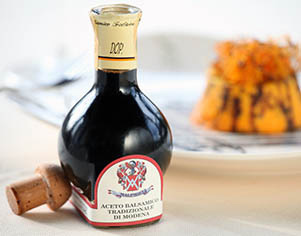是醋,是酒,是酱?身份不明、功效全能的巴萨米克醋现在可是美国餐桌上的新宠,一起来了解有关它的故事吧!

By James Dixon
穆阳 选 蒲瑶 译
|
Balsamic is an aromatic, aged types of vinegar from the concentrated juice, of white grapes (wine grapes). It has been produced for over 600 years but only became popular outside Italy after Pavarotti sang its praises in the late 1970s. Balsamic is now the best-selling vinegar in America, accounting for 45 percent of all supermarket vinegar sales. Although called a vinegar, it is nothing like the kind you might splash on your chips or pickle onions with. Instead, you might use it to dress some strawberries or drink as an aperitif. From 1300 to 1860, the northern Italian region of Reggio Emilia and Modena was a Duchy ruled by the Este family who were particularly linked to the production and usage of traditional balsamic vinegar. Throughout this time period this precious liquid can be found in notarial deeds like weddings, inheritances and donations. Records dating back to 1046, show that some of this highly regarded product was even given as a gift to emperor Henry III by the lord of Canossa. The name balsamic comes from balsam and balm which refer to its medicinal properties. The sweet, raisiny juice, skin, and seeds, called grape must, is boiled in open vats until reduced to about half its original volume. This concentrated must is added to the largest of a battery of wooden barrels, which are kept in uninsulated attics in this region where the summers are hot and the winters frosty. The battery comprises barrels of different woods—including oak, cherry, juniper, and mulberry—and sizes. The barrels aren’t sealed; they have cloth-covered openings on top to allow evaporation. Each year, before the vinegar maker adds the new must to the largest barrel, he transfers some of its ever-more concentrated contents to the next largest, and so on down the line, before finally removing a liter or two of the oldest vinegar from the smallest barrel. This is traditional balsamic vinegar. Balsamic vinegar can be used in cooking or as a salad dressing. This fruity vinegar is often used as a replacement for cooking wines because it provides similar flavoring. It is commonly cooked with chicken or sautéed vegetables. Balsamic vinegar can also be added to foods, such as spinach, after cooking to create a unique seasoning. Balsamic Health tips: Balsamic has anti-bacterial and anti-viral properties which make it an effective remedy for treating infections and wounds. Balsamic can help boost the activity of the digestive enzyme pepsin thus improving metabolism. Balsamic can reduce cholesterol level. Balsamic antioxidant may slow the aging process. Balsamic contains important minerals that can strengthen the bones. Balsamic can help prevent anemia and fatigue. Balsamic can help suppress appetite and therefore an aid in controlling weight.
|
巴萨米克醋是一种芳香陈醋,由浓缩的白葡萄(即酿酒葡萄)汁制成。巴萨米克醋已有六百多年的酿造历史,但直到20世纪70年代末因受到(意大利歌唱家)帕瓦罗蒂的盛赞才在意大利之外的地区流行开来。现在,巴萨米克醋是美国最畅销的醋,占到了超市食醋总销量的45%。虽被冠以醋之名,它却完全不同于那种用来蘸薯条或是腌洋葱的醋。它却可以用来与草莓相佐,或当开胃酒来饮用。 1300年至1860年,意大利北部的雷焦艾米利亚和摩德纳大区一直是埃斯特家族的领地,这个家族与传统的巴萨米克醋的酿造和食用颇有渊源。在当时,这种珍贵的液体可见于婚礼、遗产交接及捐赠等公证场合。早在1046年便有记载显示,这种备受尊崇的酿品还曾作为国礼由卡诺萨国王赠与亨利三世。巴萨米克醋得名于一种发音近似的香膏,后者具有药疗的特性。 将甜美的葡萄汁、葡萄皮和葡萄籽混合成的葡萄醪液置于敞口锅中煮,直至其减少到原量的二分之一。再将这种浓缩的醪液加入一排木桶里最大的一只中,存于这个夏季炎热、冬季多霜地区的非绝缘阁楼上。木桶大小各异,使用的木材也不尽相同,有橡树木、樱桃木、杜松木和桑树木。木桶不密封,以布遮盖顶部以便液体蒸发。每年,酿醋者都会向最大的桶内加入新的葡萄醪液,并将其中浓缩度更高的葡萄醪液移至第二大的木桶中,依此类推,最后于最小的桶中取出一两升年头最久的醋。这就是传统的巴萨米克醋。 巴萨米克醋既可用于烹饪,也可用来为沙拉调味。这种果醋因散发着芳香的酒气也常常代替料酒使用。它通常用来搭配鸡肉或煎蔬菜,还可浇于烹好的食物上,如菠菜,以创造出一种独特的味道。 巴萨米克醋的健康小贴士: 含有抗菌抗病毒成分,能有效治疗感染和外伤。 有助于提高胃蛋白酶的活性,提高新陈代谢。 可降低胆固醇。 具有抗氧化性,可延缓衰老。 含多种重要矿物质,可强健骨骼。 有助于预防贫血和疲劳。 有助于抑制食欲,因此有益于控制体重。 (来源:英语学习杂志) |
|
Vocabulary: aperitif (饭前饮用以促进食欲的)开胃酒 Duchy 公爵领地 notarial 由公证人经办(或处理)的 balsam (治疗或镇痛用的)香膏,后面的balm同义 sauté 〈法〉浅煎 |